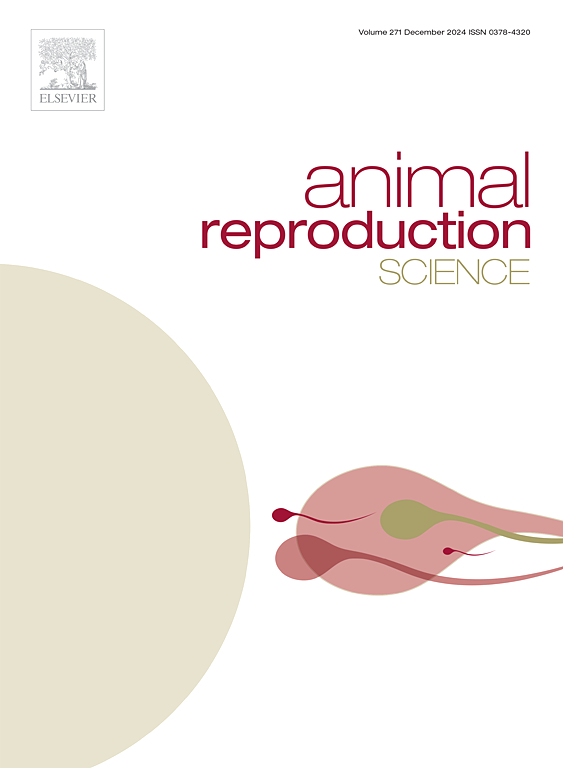Relationship between the effect of human chorionic gonadotropin treatment on the fifth day after artificial insemination and ovarian ultrasonographic findings and blood nutritional metabolic factors in dairy cows
IF 2.2
2区 农林科学
Q1 AGRICULTURE, DAIRY & ANIMAL SCIENCE
引用次数: 0
Abstract
The objective of the present study was to determine the ovarian ultrasonographic findings and metabolic factors that influence the effect of human chorionic gonadotropin (hCG) treatment on the fifth day after artificial insemination (AI) in dairy cows. Thirty-seven lactating Holstein cows were assigned to two groups: the hCG group (n = 25), which received 3000 IU of hCG intramuscularly on Day 5 after AI (day of AI = Day 0), and the control group (n = 12), which received no treatment. Ovarian ultrasonography measured luteal tissue area (LTA), luteal blood flow area (LBF), relative LBF (= LBF/LTA), and dominant follicle area on Day 5. Blood tests measured plasma insulin-like growth factor-I, insulin, and metabolite concentrations on Day 5 and plasma progesterone concentrations on Days 5 and 7. LBF was greater in pregnant cows than in non-pregnant cows, and plasma Glu concentration was lesser in pregnant cows than in non-pregnant cows, but in both cases there was no interaction between group and pregnancy outcome. For plasma insulin concentration, there was an interaction between group and pregnancy outcome, with pregnant cows in the hCG group having lesser concentrations than the other groups. Logistic regression analysis showed that group and the interaction between group and plasma insulin concentration were associated with pregnancy outcome. These results suggest that the effect of hCG treatment on Day 5 after AI is related to plasma insulin concentration and is more effective in cows with lesser plasma insulin concentrations.
人工授精后第五天人绒毛膜促性腺激素治疗效果与奶牛卵巢超声波检查结果和血液营养代谢因子之间的关系。
本研究旨在确定影响奶牛人工授精(AI)后第五天人绒毛膜促性腺激素(hCG)治疗效果的卵巢超声波检查结果和代谢因素。37头泌乳荷斯坦奶牛被分为两组:hCG组(n = 25)和对照组(n = 12),前者在人工授精后第5天(人工授精日 = 第0天)肌肉注射3000 IU hCG,后者未接受任何治疗。卵巢超声波检查在第 5 天测量黄体组织面积(LTA)、黄体血流面积(LBF)、相对 LBF(= LBF/LTA)和优势卵泡面积。血液检测测定了第 5 天的血浆胰岛素样生长因子-I、胰岛素和代谢物浓度,以及第 5 天和第 7 天的血浆孕酮浓度。妊娠奶牛的LBF高于非妊娠奶牛,妊娠奶牛的血浆Glu浓度低于非妊娠奶牛,但在这两种情况下,组别与妊娠结果之间没有交互作用。至于血浆胰岛素浓度,组别与妊娠结局之间存在交互作用,hCG 组妊娠奶牛的血浆胰岛素浓度低于其他组别。逻辑回归分析表明,组别以及组别与血浆胰岛素浓度之间的交互作用与妊娠结局有关。这些结果表明,人工授精后第5天的hCG治疗效果与血浆胰岛素浓度有关,对血浆胰岛素浓度较低的奶牛更有效。
本文章由计算机程序翻译,如有差异,请以英文原文为准。
求助全文
约1分钟内获得全文
求助全文
来源期刊

Animal Reproduction Science
农林科学-奶制品与动物科学
CiteScore
4.50
自引率
9.10%
发文量
136
审稿时长
54 days
期刊介绍:
Animal Reproduction Science publishes results from studies relating to reproduction and fertility in animals. This includes both fundamental research and applied studies, including management practices that increase our understanding of the biology and manipulation of reproduction. Manuscripts should go into depth in the mechanisms involved in the research reported, rather than a give a mere description of findings. The focus is on animals that are useful to humans including food- and fibre-producing; companion/recreational; captive; and endangered species including zoo animals, but excluding laboratory animals unless the results of the study provide new information that impacts the basic understanding of the biology or manipulation of reproduction.
The journal''s scope includes the study of reproductive physiology and endocrinology, reproductive cycles, natural and artificial control of reproduction, preservation and use of gametes and embryos, pregnancy and parturition, infertility and sterility, diagnostic and therapeutic techniques.
The Editorial Board of Animal Reproduction Science has decided not to publish papers in which there is an exclusive examination of the in vitro development of oocytes and embryos; however, there will be consideration of papers that include in vitro studies where the source of the oocytes and/or development of the embryos beyond the blastocyst stage is part of the experimental design.
 求助内容:
求助内容: 应助结果提醒方式:
应助结果提醒方式:


